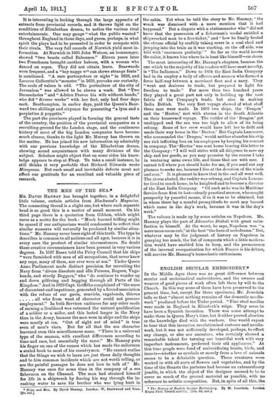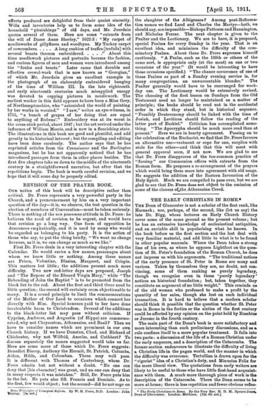ENGLISH SECULAR EMBROIDERY,
Iw the Middle Ages there was no great difference between secular and ecclesiastical embroideries, and the owners and wearers of good pieces of work often left them by will to the Church. In this way some of them have been preserved to the present time, but, except for these specimens, Mr. Jourdain tells ne that "almost nothing remains of the domestic needle- work" produced before the Tudor period. "Fine steel needles were made in England in Elizabeth's reign. They seem to have been a Spanish invention. There was some attempt to make them in Queen Mary's time, but it either proved abortive or the knowledge died with the workers. One would expect to hear that this invention revolutionised costume and needle.. work, but it was not sufficiently developed, perhaps, to effect any change, or else our ancestors, who certainly showed a remarkable talent for turning out beautiful work with very imperfect instruments, preferred their old appliances." At this time people were fond of embroidering beasts, birds, and insects—whether as symbols or merely from a love of animals seems to be a debatable question. These creatures were worked in with all sorts of flowers and vegetables, and by the time of the Stuarts the patterns bad become an extraordinary jumble, in which the object of the designer seemed to be to cover as much of the ground material as possible, with no reference to artistic composition. But, in spite of all this, the • The History of English Sender Pratiroidery. By M. Jourdain. London Regan Paul. Trench and Co. [lila. 6d. net.1
effects produced are delightful from their quaint sincerity. Wills and inventories help us to form some idea of the household " plenishings" of old days, and Mr. Jourdain quotes several of them. Here are some "extracts from the will of Dame Anne Sherley," 1622-3: "My carpet of needleworke of gillyflores and woodbyns. My Turkey carpet of cowcumbers A long cushion of trafles [trefoils] with several beasts thereon embroidered " About this
time needlework pictures and portraits became the fashion, and curious figures of men and women were introduced among the " fortles and beasts." Later came that durable and effective crewel-work that is now known as " Georgian," of which Mr. Jourdain gives an excellent example in the photograph of an elaborately embroidered hanging of the time of William III. In the late eighteenth and early nineteenth centuries much misapplied energy was devoted to copying pictures in needlework. The earliest worker in this field appears to have been a Miss Grey, of Northamptonshire, who "astonished the world of painting by her works in worsted." " I saw," writes an eye-witness, in 1755, " a bunch of grapes of her doing that are equal to anything of Rubens'." Embroidery was at its worst in the cross-stick period, about 1847 ; but the art revived under the influence of William Morris, and is now in a flourishing state. The illustrations in this book are good and plentiful, and add greatly to its historical interest ; but the compiling and editing have been done carelessly. The author says that he has reprinted articles from the Connoisseur and the Burlington magazines, but he has not apparently noticed that he has introduced passages from them in other places besides. The first five chapters take us down to the middle of the nineteenth century in a straightforward narrative, but after that the repetitions begin. The book is worth careful revision, and we hope that it will some day be properly edited.





































 Previous page
Previous page